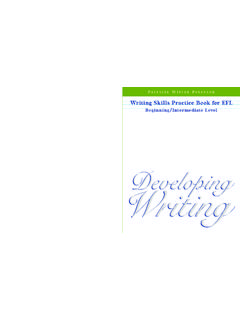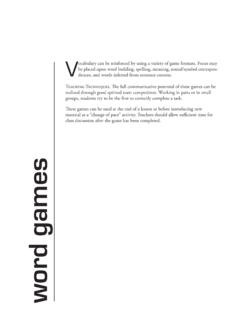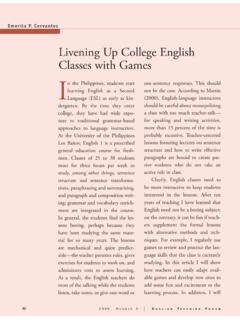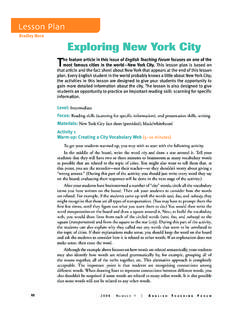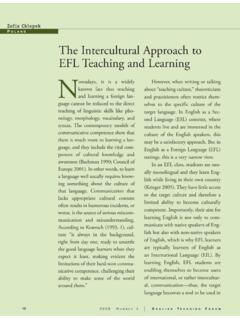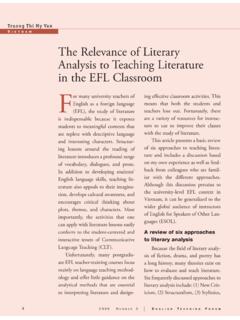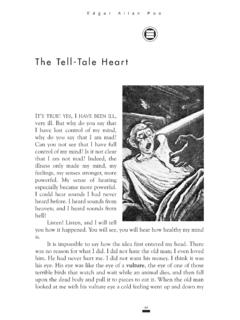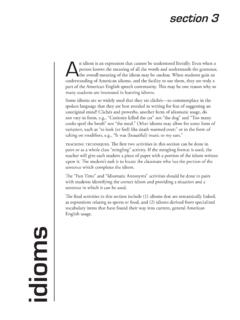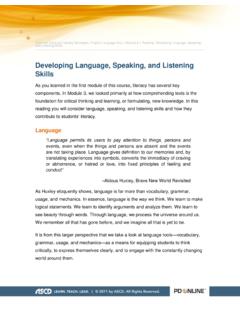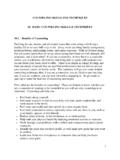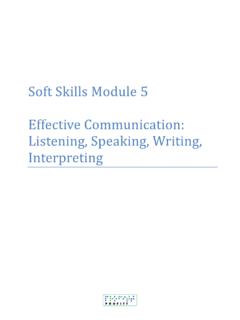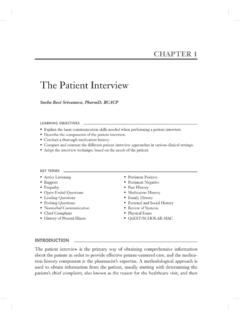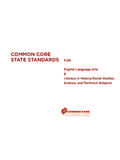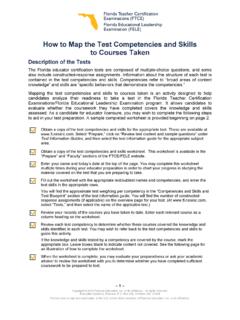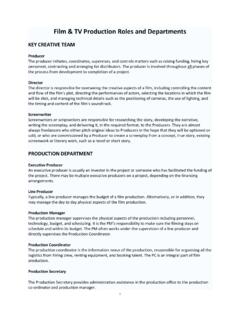Transcription of Listening Journals for Extensive and Intensive Listening ...
1 2016 ENGLISH TEACHING SCHMIDTU nited StatesListening Journals for Extensive and Intensive Listening PracticeAs a language learner, I have found that one of the most difficult skills to contend with is Listening . I was never taught how to listen. It was simply assumed that Listening skills would be naturally acquired. For my first few years as an English as a foreign language teacher, I assumed the same. However, as I reflected on my own language-learning experiences and those of my students, I rethought this assumption. I did more research on Listening instruction, and, not surprisingly, I learned that Listening in a second language is not something that is just picked up. Instead, the research points to it as a demanding cognitive task that requires a breadth and depth of exposure that neither I nor my students had been given. Through the research, I also realized that my language teachers and I were not the only ones who had made some poor assumptions.
2 It seems that throughout the history of English language teaching (ELT), most students have never been taught how to listen. According to Thorn (2009), most Listening is done for non- Listening purposes, such as introducing grammar or vocabulary, for discussion, for testing comprehension (but not actually to learn how to comprehend), and for familiarity with different accents. Rarely will someone claim to use Listening in class to train students to listen more effectively (Thorn 2009, 9). According to Brown (2011, 36), playing audio and asking comprehension questions, or even playing audio and asking students to complete tasks, is merely testing. Therefore, a great deal of Listening practice focuses on testing Listening , not teaching it. Testing a skill without first teaching it would not be acceptable for reading, writing, or speaking, and therefore it should not be acceptable for Listening instruction does occur, it is mostly a top-down approach.
3 Thorn (2009) again points out that the focus is on schema building, gist, and guessing, not the words and sounds that actually make Listening challenging. Furthermore, the Listening texts themselves often pose a problem Thorn (2009) believes that most texts are uninteresting from the students perspective, lack natural language features ( , linking or elision), and utilize one standard accent. None of this prepares students very well for the real-world Listening challenges they will encounter. While these methods of Listening instruction still remain the dominant paradigm in ELT, they are slowly changing. Based on my experience as a language learner, on second- language Listening research, and on some 2016 ENGLISH TEACHING trends in Listening instruction, I have designed a method that uses Listening Journals to deal with the challenges of learning to listen in a second language. This article introduces the concept of Listening Journals and explains how teachers can use them to focus on both the Extensive and Intensive aspects of Listening in order to help students improve their overall Listening RESEARCH OVERVIEWC learly, students need a more focused approach to Listening instruction.
4 Recent research from an array of areas indicates that top-down approaches (activating prior knowledge), bottom-up approaches (decoding sounds), and metacognitive approaches (predicting, monitoring, and planning) are all essential for students to become good listeners (see Brown 2011 for an overview). While current Listening instruction generally focuses on top-down approaches, bottom-up processing skills are increasingly recognized as important. The lack of phonological awareness and the inability to decode sounds or draw word boundaries are seen as major hindrances to Listening (Kiany and Shiramiry 2002; Field 2003, 2008; Wilson 2003), and a shift from top-down to bottom-up Listening instruction is supported by a number of research studies (Wilson 2003; Thorn 2009; Renandya and Farrell 2011).Decoding skills are one piece of the puzzle. Just as learning to read well requires one to do a great deal of reading, learning to listen well requires one to do a great deal of Listening .
5 Inspired by Extensive reading, an Extensive approach to Listening has been gaining support in ELT. Proponents suggest that students should listen to a great amount and variety of enjoyable texts at appropriate levels to build Listening -comprehension skills (Renandya and Farrell 2011; Chang and Millett 2014). While the Listening sources do not need to be authentic to be effective, some research indicates the positive effect of using authentic materials in terms of their motivating qualities and success at improving Listening (Mousavi and Iravani 2012; Thorn 2009). Authentic sources such as videos can be made more accessible to learners through the use of subtitles and captioning, which also have a positive effect on Listening (Woodall 2010; Chang and Millett 2014). Listening JOURNALSThe research suggests a clear and desired need for a stronger Intensive and Extensive approach to Listening instruction. Not only do students need to do more Listening , but they need to do this Listening in conjunction with an approach that helps them focus on sounds, words, and building meaning from the bottom up as well as the top down.
6 Listening Journals are one tool I have used to serve these Listening journal is a book in which students record their Extensive and Intensive Listening practices, as well as reflections on their Listening experiences. The Extensive Listening aspect of Listening Journals requires students to choose and listen to texts that appeal to them from a source provided by the teacher. Students typically listen to a text several times while focusing on meaning. It is recommended that the selected texts have subtitles or transcripts for follow-up Intensive activities. These texts are often authentic media from websites like , although for lower levels there are many options for media made specifically for language learners, such as and (see for a full list of sources). For students without access to computer technology, sources may include the teacher or guest speakers from the community. A Listening journal is a book in which students record their Extensive and Intensive Listening practices, as well as reflections on their Listening TEACHING from Extensive Listening to Intensive practice, students take these texts and focus on decoding or other related skills in order to train their Listening abilities.
7 Popular and effective activities in this area include completing gap fills and transcriptions; however, prosody marking and pronunciation activities are also useful. Finally, students reflect on their successes, strengths, and weaknesses in order to identify skills they need to improve. Strengthening these weaker skills becomes a goal for students to focus on during further Listening practice in the classroom, outside the classroom, or in subsequent Listening these activities are recorded in the Listening journal and submitted once a week. For example, a website and series of activities are introduced and demonstrated on Monday; students choose a video from that website and complete the template, and then the students work is collected the following Monday. Each week, the source and activity can remain the same or be changed. Listening Journals can be handwritten in a notebook or follow a premade template. Templates can be tailored for specific activities, or they can be general templates suitable for any activity (see the Appendixes for examples).
8 Another way to use Listening Journals is to provide a small book, or packet, of journal templates at the beginning of the course, along with a number of websites appropriate for the students level, and providing a quick demonstration of each site and activity. Students visit any of the sites each week and select and listen to a video of their choice. For any video, they should follow the same activities, which include meaning-based Listening followed by Intensive Listening activities. Students complete these Journals on their own time and submit their book or packet several times throughout the course (an example of this can be found at ). Depending on the number of students, the goals of the course, and the assessed weight of Listening Journals , the Journals also can be collected daily, semi-weekly, or monthly. They can be assessed on any number of criteria, including completeness, correctness, effort, and quality. WEB-BASED Listening JOURNAL ACTIVITIESF ollowing are examples of activities that can be conducted in conjunction with keeping a Listening journal.
9 The goals of the first two Listening journal activities for upper-intermediate to advanced students are to focus on main ideas and on details, practice note-taking skills , and build decoding skills . The Listening source is a TED Talk from , and students are instructed to find a video that can provide subtitles and transcripts both in English and their native language. First, I outline these two Listening journal activities for upper-intermediate to advanced students, as well as the rationale for the activities. Following the TED Talk activities, I outline a Listening journal activity and rationale for intermediate students from activities for upper-intermediate to advanced studentsOverview: Watch a short lecture, take notes, complete a gap fill, and use subtitles to find gaps in your Listening and Listening -comprehension : Write video title, video summary, and reflections in the Listening journal (see Appendix 1 for template example), take notes in the Listening journal, and print the gap 1: (your personal Listening goal)Goal 2: Listening for the main ideas and specific detailsGoal 3: understanding specific wordsListening Journals can be handwritten in a notebook or follow a premade TEACHING THE TED TALK Listening SOURCEGo to and find an interesting video by clicking the Watch or Discover tabs or by using the Search function.
10 After pressing the play button, you will see a small Subtitles icon below the video on the right. Make sure the selected video has subtitles in English and your first language by clicking the icon. Note: I recommend the video by Carol Dweck, The Power of Believing That You Can Improve, which discusses the idea that we can grow our brain s capacity to learn and to solve problems. Subtitles are available in Chinese, Korean, Spanish, and many other languages. However, your students may choose any video!TED TALK ACTIVITY 11. You will need three pens, each of a different color ( , black, blue, and red).2. First, watch the TED Talk video without subtitles. Do not pause the video. Take notes in the Notes section. 3. Second, watch the video with English subtitles. Do not pause the video. Add more information to your notes using a pen with a different color ink. 4. Finally, watch the video using subtitles in your first language. Add more information to your notes using a pen with a different color.
